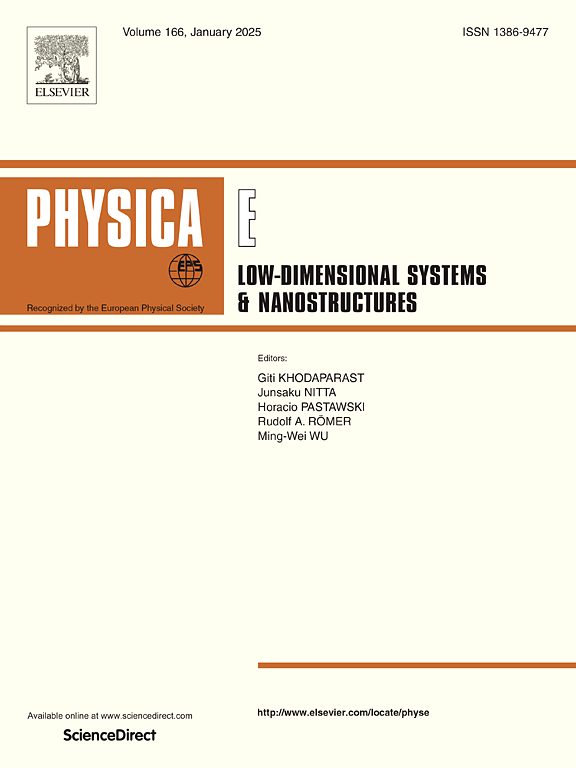Edge effect induce spin-gapless semiconducting and half-metallic properties of N-doped zigzag graphene nanoribbons
IF 2.9
3区 物理与天体物理
Q3 NANOSCIENCE & NANOTECHNOLOGY
Physica E-low-dimensional Systems & Nanostructures
Pub Date : 2025-02-01
DOI:10.1016/j.physe.2024.116172
引用次数: 0
Abstract
Graphene nanoribbons with mixed edge structures are promising candidate materials for the next generation of nanoelectronics due to their unique and peculiar physical and chemical properties, as well as their interesting and tunable electronic structures. Here, we designs and calculates a series of periodic edge N-doped ZGNRs using first principles calculations based on density functional theory. The band gap of these ZGNRs can be adjusted from metal to semiconductor, by the periodic length of the nanobands, and the number and interval distance of N atom doping. Among them, 6-ZGNR-(1,3) is a metallic, 6-ZGNR-(1,4) and 6-ZGNR-(2,4) are half-metallic, 6-ZGNR-(2,5) and 6-ZGNR-(3,5) are SGS, and 6-ZGNR-(3,6) is a magnetic semiconductor. We projected band structures into px orbitals of edge C and N atoms separately, and found that the energy near the Fermi level in 6-ZGNR-(1,4) is mainly contributed by edge C atoms, while 6-ZGNR-(3,5) is contributed by edge N atoms. This indicates that N atom doping plays a major role in the transition of spin polarization properties. Our studies suggest that it will have significant theoretical significance and practical value in the application of spintronic devices.
边缘效应诱导了氮掺杂之字形石墨烯纳米带的半导体和半金属性质
具有混合边缘结构的石墨烯纳米带由于其独特的物理和化学性质以及有趣的可调谐电子结构而成为下一代纳米电子学的候选材料。本文采用基于密度泛函理论的第一性原理计算,设计并计算了一系列周期性边缘掺杂n的zgnr。这些zgnr的带隙可以通过纳米带的周期长度、N原子掺杂的数量和间隔距离从金属到半导体进行调节。其中,6 - zgnr -(1,3)为金属,6 - zgnr -(1,4)和6- zgnr -(2,4)为半金属,6 - zgnr -(2,5)和6- zgnr -(3,5)为SGS, 6- zgnr -(3,6)为磁性半导体。我们将能带结构分别投影到边缘C和N原子的px轨道上,发现6-ZGNR-(1,4)中费米能级附近的能量主要由边缘C原子贡献,而6-ZGNR-(3,5)中费米能级附近的能量主要由边缘N原子贡献。这表明N原子掺杂在自旋极化性质的转变中起着重要作用。我们的研究表明,这对自旋电子器件的应用具有重要的理论意义和实际价值。
本文章由计算机程序翻译,如有差异,请以英文原文为准。
求助全文
约1分钟内获得全文
求助全文
来源期刊
CiteScore
7.30
自引率
6.10%
发文量
356
审稿时长
65 days
期刊介绍:
Physica E: Low-dimensional systems and nanostructures contains papers and invited review articles on the fundamental and applied aspects of physics in low-dimensional electron systems, in semiconductor heterostructures, oxide interfaces, quantum wells and superlattices, quantum wires and dots, novel quantum states of matter such as topological insulators, and Weyl semimetals.
Both theoretical and experimental contributions are invited. Topics suitable for publication in this journal include spin related phenomena, optical and transport properties, many-body effects, integer and fractional quantum Hall effects, quantum spin Hall effect, single electron effects and devices, Majorana fermions, and other novel phenomena.
Keywords:
• topological insulators/superconductors, majorana fermions, Wyel semimetals;
• quantum and neuromorphic computing/quantum information physics and devices based on low dimensional systems;
• layered superconductivity, low dimensional systems with superconducting proximity effect;
• 2D materials such as transition metal dichalcogenides;
• oxide heterostructures including ZnO, SrTiO3 etc;
• carbon nanostructures (graphene, carbon nanotubes, diamond NV center, etc.)
• quantum wells and superlattices;
• quantum Hall effect, quantum spin Hall effect, quantum anomalous Hall effect;
• optical- and phonons-related phenomena;
• magnetic-semiconductor structures;
• charge/spin-, magnon-, skyrmion-, Cooper pair- and majorana fermion- transport and tunneling;
• ultra-fast nonlinear optical phenomena;
• novel devices and applications (such as high performance sensor, solar cell, etc);
• novel growth and fabrication techniques for nanostructures

 求助内容:
求助内容: 应助结果提醒方式:
应助结果提醒方式:


